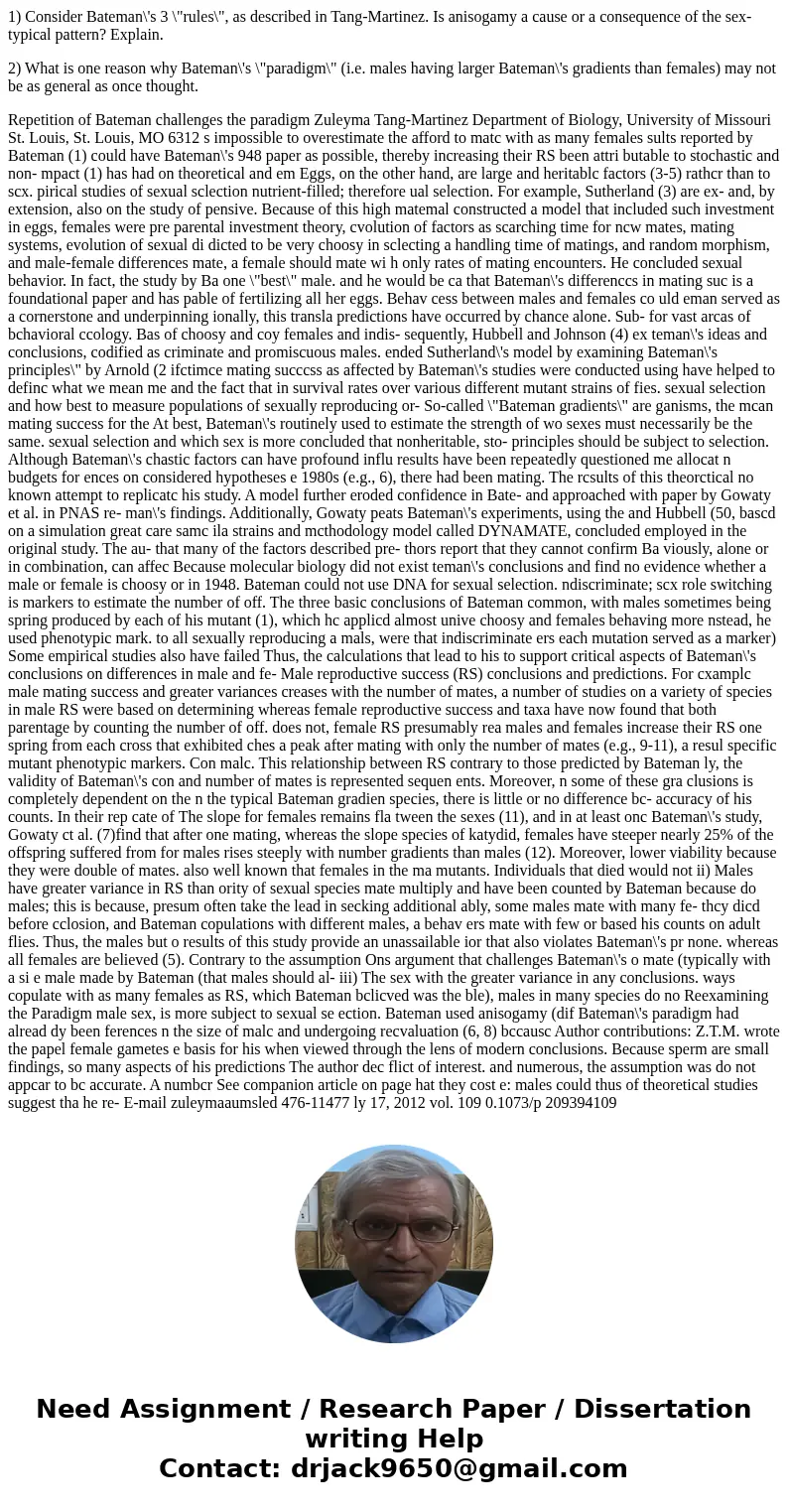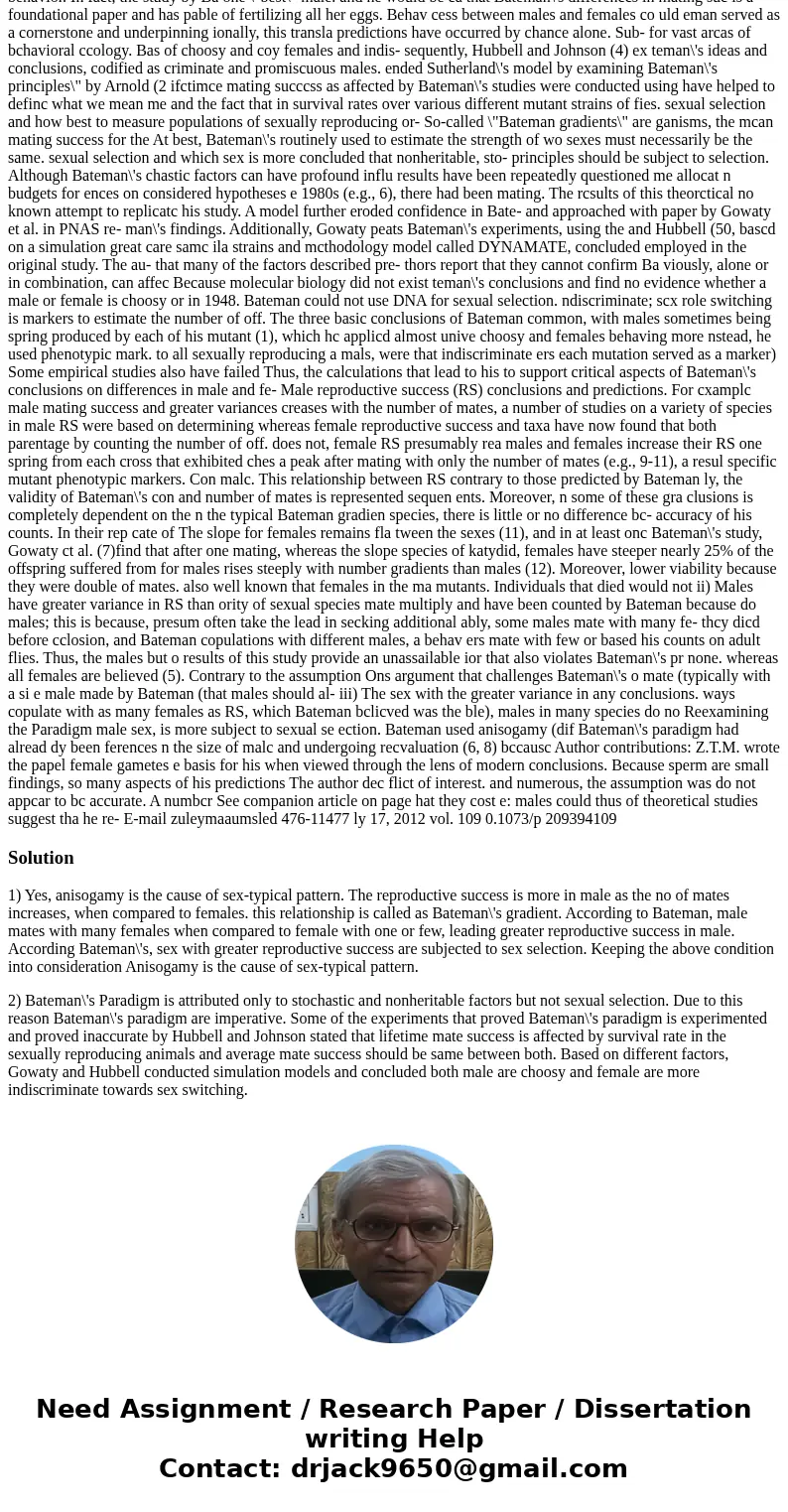1 Consider Batemans 3 rules as described in TangMartinez Is
1) Consider Bateman\'s 3 \"rules\", as described in Tang-Martinez. Is anisogamy a cause or a consequence of the sex-typical pattern? Explain.
2) What is one reason why Bateman\'s \"paradigm\" (i.e. males having larger Bateman\'s gradients than females) may not be as general as once thought.
Repetition of Bateman challenges the paradigm Zuleyma Tang-Martinez Department of Biology, University of Missouri St. Louis, St. Louis, MO 6312 s impossible to overestimate the afford to matc with as many females sults reported by Bateman (1) could have Bateman\'s 948 paper as possible, thereby increasing their RS been attri butable to stochastic and non- mpact (1) has had on theoretical and em Eggs, on the other hand, are large and heritablc factors (3-5) rathcr than to scx. pirical studies of sexual sclection nutrient-filled; therefore ual selection. For example, Sutherland (3) are ex- and, by extension, also on the study of pensive. Because of this high matemal constructed a model that included such investment in eggs, females were pre parental investment theory, cvolution of factors as scarching time for ncw mates, mating systems, evolution of sexual di dicted to be very choosy in sclecting a handling time of matings, and random morphism, and male-female differences mate, a female should mate wi h only rates of mating encounters. He concluded sexual behavior. In fact, the study by Ba one \"best\" male. and he would be ca that Bateman\'s differenccs in mating suc is a foundational paper and has pable of fertilizing all her eggs. Behav cess between males and females co uld eman served as a cornerstone and underpinning ionally, this transla predictions have occurred by chance alone. Sub- for vast arcas of bchavioral ccology. Bas of choosy and coy females and indis- sequently, Hubbell and Johnson (4) ex teman\'s ideas and conclusions, codified as criminate and promiscuous males. ended Sutherland\'s model by examining Bateman\'s principles\" by Arnold (2 ifctimce mating succcss as affected by Bateman\'s studies were conducted using have helped to definc what we mean me and the fact that in survival rates over various different mutant strains of fies. sexual selection and how best to measure populations of sexually reproducing or- So-called \"Bateman gradients\" are ganisms, the mcan mating success for the At best, Bateman\'s routinely used to estimate the strength of wo sexes must necessarily be the same. sexual selection and which sex is more concluded that nonheritable, sto- principles should be subject to selection. Although Bateman\'s chastic factors can have profound influ results have been repeatedly questioned me allocat n budgets for ences on considered hypotheses e 1980s (e.g., 6), there had been mating. The rcsults of this theorctical no known attempt to replicatc his study. A model further eroded confidence in Bate- and approached with paper by Gowaty et al. in PNAS re- man\'s findings. Additionally, Gowaty peats Bateman\'s experiments, using the and Hubbell (50, bascd on a simulation great care samc ila strains and mcthodology model called DYNAMATE, concluded employed in the original study. The au- that many of the factors described pre- thors report that they cannot confirm Ba viously, alone or in combination, can affec Because molecular biology did not exist teman\'s conclusions and find no evidence whether a male or female is choosy or in 1948. Bateman could not use DNA for sexual selection. ndiscriminate; scx role switching is markers to estimate the number of off. The three basic conclusions of Bateman common, with males sometimes being spring produced by each of his mutant (1), which hc applicd almost unive choosy and females behaving more nstead, he used phenotypic mark. to all sexually reproducing a mals, were that indiscriminate ers each mutation served as a marker) Some empirical studies also have failed Thus, the calculations that lead to his to support critical aspects of Bateman\'s conclusions on differences in male and fe- Male reproductive success (RS) conclusions and predictions. For cxamplc male mating success and greater variances creases with the number of mates, a number of studies on a variety of species in male RS were based on determining whereas female reproductive success and taxa have now found that both parentage by counting the number of off. does not, female RS presumably rea males and females increase their RS one spring from each cross that exhibited ches a peak after mating with only the number of mates (e.g., 9-11), a resul specific mutant phenotypic markers. Con malc. This relationship between RS contrary to those predicted by Bateman ly, the validity of Bateman\'s con and number of mates is represented sequen ents. Moreover, n some of these gra clusions is completely dependent on the n the typical Bateman gradien species, there is little or no difference bc- accuracy of his counts. In their rep cate of The slope for females remains fla tween the sexes (11), and in at least onc Bateman\'s study, Gowaty ct al. (7)find that after one mating, whereas the slope species of katydid, females have steeper nearly 25% of the offspring suffered from for males rises steeply with number gradients than males (12). Moreover, lower viability because they were double of mates. also well known that females in the ma mutants. Individuals that died would not ii) Males have greater variance in RS than ority of sexual species mate multiply and have been counted by Bateman because do males; this is because, presum often take the lead in secking additional ably, some males mate with many fe- thcy dicd before cclosion, and Bateman copulations with different males, a behav ers mate with few or based his counts on adult flies. Thus, the males but o results of this study provide an unassailable ior that also violates Bateman\'s pr none. whereas all females are believed (5). Contrary to the assumption Ons argument that challenges Bateman\'s o mate (typically with a si e male made by Bateman (that males should al- iii) The sex with the greater variance in any conclusions. ways copulate with as many females as RS, which Bateman bclicved was the ble), males in many species do no Reexamining the Paradigm male sex, is more subject to sexual se ection. Bateman used anisogamy (dif Bateman\'s paradigm had alread dy been ferences n the size of malc and undergoing recvaluation (6, 8) bccausc Author contributions: Z.T.M. wrote the papel female gametes e basis for his when viewed through the lens of modern conclusions. Because sperm are small findings, so many aspects of his predictions The author dec flict of interest. and numerous, the assumption was do not appcar to bc accurate. A numbcr See companion article on page hat they cost e: males could thus of theoretical studies suggest tha he re- E-mail zuleymaaumsled 476-11477 ly 17, 2012 vol. 109 0.1073/p 209394109Solution
1) Yes, anisogamy is the cause of sex-typical pattern. The reproductive success is more in male as the no of mates increases, when compared to females. this relationship is called as Bateman\'s gradient. According to Bateman, male mates with many females when compared to female with one or few, leading greater reproductive success in male. According Bateman\'s, sex with greater reproductive success are subjected to sex selection. Keeping the above condition into consideration Anisogamy is the cause of sex-typical pattern.
2) Bateman\'s Paradigm is attributed only to stochastic and nonheritable factors but not sexual selection. Due to this reason Bateman\'s paradigm are imperative. Some of the experiments that proved Bateman\'s paradigm is experimented and proved inaccurate by Hubbell and Johnson stated that lifetime mate success is affected by survival rate in the sexually reproducing animals and average mate success should be same between both. Based on different factors, Gowaty and Hubbell conducted simulation models and concluded both male are choosy and female are more indiscriminate towards sex switching.


 Homework Sourse
Homework Sourse